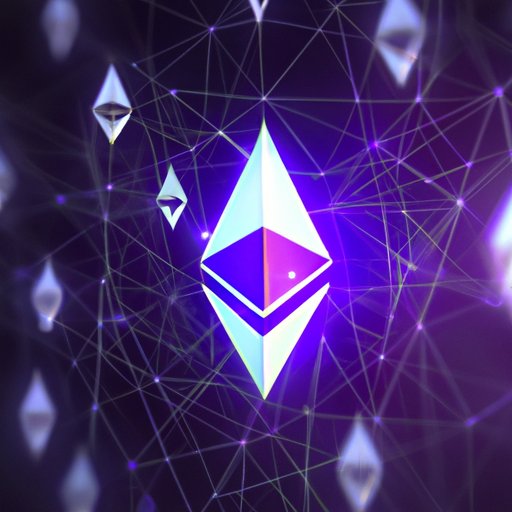Introduction
Ethereum is an open-source, public, blockchain-based distributed computing platform featuring smart contract (scripting) functionality. It provides a decentralized virtual machine that can execute scripts using an international network of public nodes. Ethereum was proposed in 2013 by Vitalik Buterin, a Russian-Canadian programmer and co-founder of Bitcoin Magazine. The purpose of Ethereum is to be a platform for developers to build decentralized applications (DApps) that are secure from third-party interference. This article will explore how Ethereum works and provide a better understanding of its underlying technologies.
Overview of Ethereum’s Underlying Technology
The foundation of Ethereum is built on two components: a distributed ledger and blockchain technology. A distributed ledger is a database that is spread across multiple sites, institutions, or participants. In the case of Ethereum, it is maintained by a global network of computers. Blockchain technology uses cryptography and digital signatures to ensure the security, accuracy, and privacy of data stored on the distributed ledger.
In addition to the distributed ledger and blockchain technology, Ethereum also serves as a decentralized application platform. This means that developers can create and deploy applications that are secured from third-party interference and censorship. Ethereum allows developers to build DApps without having to worry about the underlying infrastructure and security of their applications.

Explaining the Basics of Ethereum Transactions
Ethereum transactions involve the use of wallets and accounts. Each user has a wallet that stores their cryptocurrency, such as Ether. This wallet is used to send and receive transactions. The wallet is associated with an account, which is an address on the Ethereum network. Users can generate as many accounts as they wish and each account will have its own unique address.
When a transaction is sent, Ether tokens are used to pay the fee. Ether is a cryptocurrency based on the Ethereum blockchain and is the primary currency used to power the network. Transactions require “gas” to be paid, which is the amount of Ether needed to complete the transaction. The amount of gas required depends on the type of transaction being sent.
There are three types of transactions that can be sent on the Ethereum network: value transfers, message calls, and contract executions. Value transfers are the simplest form of transaction and are used to transfer Ether from one account to another. Message calls allow users to call functions within a contract, while contract executions are used to initiate or change the state of a smart contract.

Ethereum Mining and Consensus Algorithms
Ethereum uses a proof-of-work consensus algorithm to verify transactions and add new blocks to the blockchain. This involves miners competing against each other to solve complex mathematical problems in order to add a new block of transactions to the blockchain. When a miner successfully adds a new block, they are rewarded with Ether tokens. This incentivizes miners to continue to contribute to the Ethereum network.

Understanding the Ethereum Virtual Machine
The Ethereum Virtual Machine (EVM) is a runtime environment for smart contracts. It allows developers to write code that runs on the Ethereum blockchain. The EVM is responsible for executing smart contracts and ensuring that all parties involved in the contract adhere to the conditions set forth. The EVM is Turing-complete, meaning it can execute any code written in a programming language.
Smart Contracts on Ethereum
Smart contracts are self-executing contracts that are written in code and stored on the blockchain. They facilitate the exchange of money, property, or anything of value between two or more parties without the need for a middleman or intermediary. Smart contracts are designed to be tamper-proof and are enforced by the blockchain network. This ensures that all parties involved in the contract adhere to the conditions set forth.
Smart contracts offer several benefits, including trustless transactions, automated execution, and reduced costs. They can be used to automate a variety of tasks and are often used to facilitate agreements between two or more parties. For example, smart contracts can be used to automate payments, escrow services, and asset management.
Decentralized Applications Built on Ethereum
Decentralized applications (DApps) are applications that run on a distributed network of computers rather than a single computer or server. They are powered by smart contracts and run on the Ethereum blockchain. DApps offer several advantages over traditional applications, including improved security, transparency, and autonomy. DApps are often used to create decentralized marketplaces, prediction markets, and gaming platforms.
Conclusion
In conclusion, Ethereum is an open-source, public, blockchain-based distributed computing platform featuring smart contract (scripting) functionality. It provides a decentralized virtual machine that can execute scripts using an international network of public nodes. Ethereum’s underlying technology includes distributed ledger and blockchain technology, wallets and accounts, Ether tokens and gas, types of transactions, mining rewards, the Ethereum Virtual Machine, and smart contracts. Decentralized applications built on Ethereum can also benefit from its features and offer improved security, transparency, and autonomy.
(Note: Is this article not meeting your expectations? Do you have knowledge or insights to share? Unlock new opportunities and expand your reach by joining our authors team. Click Registration to join us and share your expertise with our readers.)
